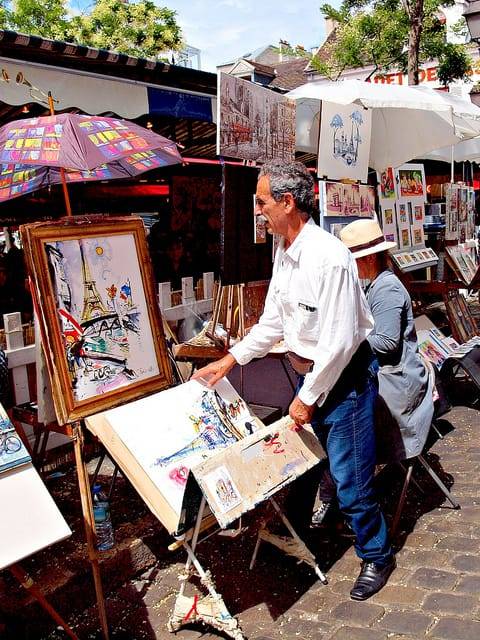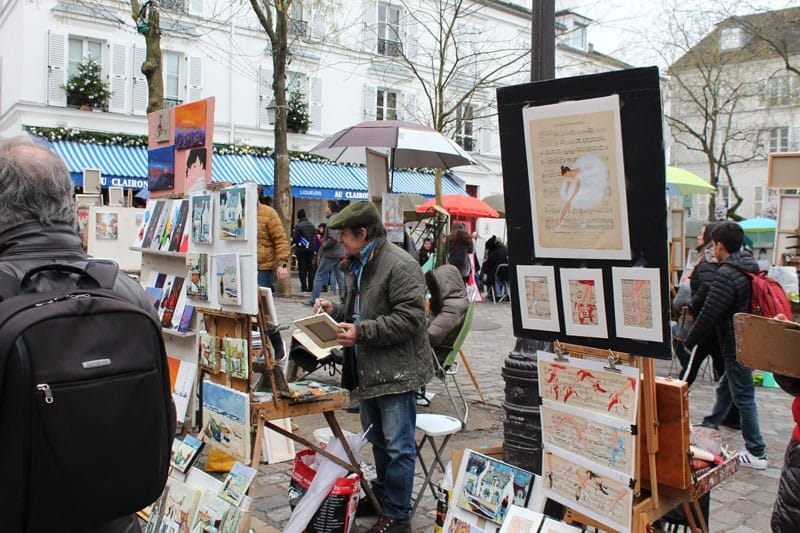In the heart of the city, amidst the hustle and bustle, a unique kind of magic unfolds. It’s a place where creativity meets commerce, where passion meets patronage. Welcome to the world of selling art on the street, a vibrant, pulsating marketplace that is as diverse and dynamic as the cities that host it.
Street art sales have exploded in popularity over the years, transforming sidewalks and parks into open-air galleries. These spaces have become a haven for artists who seek to break free from the confines of traditional galleries. They offer an unfiltered, uncurated experience, where the only thing separating the artist and the audience is the thin line of chalk that defines their stall.

Why is selling art on the street more than just a buzzword? It’s because it represents a shift in how we consume art. No longer are art pieces confined to the hushed, reverent halls of museums or the pristine, white walls of galleries. Visual art has stepped down from its pedestal, and it’s now within arm’s reach, a part of our everyday lives.
The allure of the open-air gallery lies in its accessibility. It’s a place where art enthusiasts can engage directly with artists, witness the creative process unfold before their eyes, and take home a piece of art without breaking the bank. It’s a place where artists can connect with their audience on a personal level, where they can receive instant feedback, where they can experiment and evolve without fear of judgment.
But selling art on the street is not just about the transaction. It’s about the stories shared, the connections made, and the inspiration sparked. It’s about the artist who finds their voice, the passerby who finds beauty in an unexpected place, and the city that finds its soul.
So, let’s embark on this journey together, exploring the allure, the challenges, and the triumphs of selling art on the street.
The Artistic Street Culture
As we step into the vibrant world of street art, it’s essential to understand the culture that breathes life into it. Street culture is a kaleidoscope of sights, sounds, and stories, a living, breathing entity that thrives on diversity and dynamism. And at its heart, pulsating with creativity and courage, are the artists.
Artists are the heartbeat of the urban jungle, their creations adding color and character to the cityscape. They transform blank walls into murals, empty corners into installations, and bustling sidewalks into open-air galleries. They are the storytellers of the street, their art reflecting the spirit of the city and the soul of its people.
If you’re an artist considering selling your art on the street, it’s crucial to immerse yourself in this culture. Here’s how:
1. Explore and Engage: Spend time exploring different street art scenes. Visit various neighborhoods, attend street art festivals, and engage with other artists. This will not only inspire you but also help you understand what resonates with the audience.
2. Experiment and Express: Street culture thrives on innovation and individuality. Don’t be afraid to experiment with different styles, mediums, and themes. Remember, your art is an expression of your unique perspective. Let it reflect your experiences, your emotions, your essence.
3. Educate and Evolve: Stay informed about the latest trends and techniques in street art. Attend workshops, follow influential street artists, and learn from their journey. This will help you evolve as an artist and keep your art relevant.
4. Exhibit and Excite: Finally, start exhibiting your art on the street. Start small, perhaps with a few pieces at a local market or a small corner of a park. Observe how people interact with your art, listen to their feedback, and learn from the experience. Remember, every interaction is an opportunity to excite your audience and elevate your art.
As we delve deeper into the world of selling art on the street, remember that you’re not just an artist; you’re part of a vibrant, evolving culture. Embrace it, contribute to it, and let it inspire your journey. After all, the street is more than just a marketplace; it’s a canvas for your creativity, a stage for your story, and a home for your art.
Choosing the Right Location for Your Street Art Sales
Finding the perfect spot for showcasing and selling your masterpieces can make all the difference in your success as a street artist. To sell your art effectively, it’s essential to choose a location with:
- high foot traffic
- good visibility
- and a strong connection to the art scene.
Start by exploring popular spots like busy sidewalks, markets, or parks, anywhere you’ll find other artists and vendors. Remember to check local regulations and obtain the necessary vendor license before setting up in a public place.

When selecting a place to sell and display your artwork, consider the type of audience you want to attract. If your art is more avant-garde, choose a location near galleries or cultural institutions where art enthusiasts are more likely to gather. On the other hand, if your work is more accessible and appealing to a broader audience, set up your stand near popular tourist spots or shopping centers.
Don’t be afraid to experiment with different locations to see which one works best for you – after all, innovation is key to standing out in the street art scene.
The Sunny Side of Street Art Sales

The street, with its raw energy and vibrant diversity, provides a platform like no other for artists to showcase their work. Here are some of the sunny sides of selling art on the street:
1. The Power of Personal Interaction: There’s something incredibly rewarding about seeing someone’s eyes light up as they discover your art. Selling art on the street allows for this direct, personal interaction with potential buyers. You get to share the stories behind your creations, answer questions, and even demonstrate your process. This connection can often be the difference between a casual glance and a purchase. So, as you step onto the pavement, palette in hand, remember: every interaction is an opportunity, every challenge a chance to evolve, and every sale a testament to your talent.
2. Freedom to Fly: Unlike selling your work in galleries that operate on set schedules, the street offers you the freedom to choose when and where you sell your art. Love the morning light in the park? Set up your stall there. Find the weekend crowd more engaging? Choose that time for your display. This flexibility allows you to work at your own pace and in your preferred environment.
3. Low-Cost, High Reward: Renting a gallery space can be expensive. In contrast, selling art on the street often requires minimal investment for a stall or a permit. This low overhead cost means you can price your art more affordably, making it accessible to a wider audience and potentially really good money for you as an artist.
4. Instant Reviews: Feedback is crucial for any artist, and selling art on the street provides it in real time. You get to observe firsthand how people react to your work, which pieces draw more attention, and what kind of art gets sold faster. This immediate feedback can be invaluable in refining your style and approach.
The Shadows of Street Art Sales

It’s not all sunshine and roses when it comes to showcasing your creative masterpieces in public spaces. As we journey through the world of street art sales, it’s essential to acknowledge the shadows that come with the sunny side.
While liberating and rewarding, selling art on the street also presents its own set of challenges. In bustling places like New York City, street art sales are subject to unpredictable weather conditions, legal restrictions, and the ever-present risk of theft or damage to your precious artwork. Not to mention, the income you earn from selling your creations on the sidewalk can be wildly inconsistent, making it difficult to rely on this method as your primary source of revenue.
But fear not, for every cloud has a silver lining, and every challenge is an opportunity for growth. Let’s explore some of these challenges and how to navigate them:
1. The Weather Wager: Mother Nature can be a fickle friend. One day, she graces you with sunshine and a gentle breeze, the next, she sends rain or scorching heat. Protecting your art from the elements is crucial. Invest in a sturdy, weather-resistant tent or canopy. Also, consider using materials that can withstand weather changes, and always have a plan B for unexpected weather shifts.
2. The Red Tape Tango: Depending on your city’s regulations, you may need permits to sell art on the street. Navigating this bureaucratic maze can be daunting, but it’s essential to stay on the right side of the law. Research local ordinances, apply for necessary permits, and always respect public spaces. Remember, the street is your gallery, treat it with care.
3. The Income Rollercoaster: Street art sales can be unpredictable. Some days, you might sell several pieces; other days, you might return home with your art unsold. Financial uncertainty is part of the package. To manage this, diversify your income sources. Consider selling other commercial merchandise incorporating your art such as prints and jigsaw puzzles, offering art classes, or creating commissioned pieces.
4. Guarding Your Creations: Unfortunately, theft and damage are potential risks when selling art on the street. To protect your art collection, consider insurance. Display your art securely, keep an eye on your stall, and if possible, have someone with you to help monitor your space.
While these challenges may seem daunting, remember that they are part and parcel of the street art sales journey. They test your resilience, spark your creativity, and ultimately, strengthen your artistry. So, as you step out onto the street, palette in hand, remember: every challenge is a brushstroke on the canvas of your journey, adding depth, texture, and character to your story as an artist.

Mastering the Art of Street Sales
How can you master the art of street sales? Here are some essential tips to help you captivate your audience, create a memorable experience, and ultimately, sell your art:
1. Understanding the Street Symphony: The street is a symphony of sights, sounds, and stories. To be successful, you need to understand its rhythm. Observe the crowd. What kind of art do they gravitate towards? What are their preferences? Use these insights to tailor your art and your sales approach.
2. The Art of Pricing: Pricing your art can be a delicate balancing act. You want to value your time, effort, and creativity, but you also want to make your art accessible. Research prices for similar art, consider your costs, and factor in your unique style and skill. Remember, the right price can turn an admirer into a buyer.
3. Displaying with Drama: Your display is your stage, make it dramatic. Arrange your art in a way that catches the eye. Use varying heights, play with lights and colors, and create a focal point. A captivating display can draw the crowd to your stall.
4. Building Bonds: Selling art on the street is not just about the transaction; it’s about the connection. Engage with your audience. Share the stories behind your art, answer their questions, and show your passion. These connections can turn a casual visitor into a loyal customer.
5. Navigating the Legal Labyrinth: As we discussed earlier, selling art on the street may require permits. Stay informed about local regulations, renew your permits on time, and always respect public spaces. A legal misstep can disrupt your sales and damage your reputation.
Mastering the art of street sales requires patience, persistence, and a lot of practice. But remember, every interaction is a learning experience, every sale a validation of your talent, and every challenge a stepping stone to success. So, step onto the street with confidence, let your art shine, and let the symphony of the street guide your journey.
Building a Customer Base Through Your Street Sales
By forging genuine connections with passersby and showcasing your distinct style, you’ll gradually cultivate a loyal customer base that appreciates your creations and contributes to the growth of your artistic enterprise. Building a customer base through street sales is all about consistency, being authentic, and providing contextually relevant and appealing content to your potential clients.
To ensure your success in selling art on the street, focus on the following key strategies:
- Engage with potential customers by sharing your story and creative process, making your art more relatable and personal.
- Showcase a diverse range of work to cater to different tastes and preferences, while maintaining your unique artistic voice.
- Offer limited edition or exclusive pieces, tapping into the innate desire for innovation and exclusivity.
- Encourage satisfied customers to spread the word about your art, leveraging the power of word-of-mouth marketing.
- Utilize social media platforms to connect with your audience, share your latest creations, and announce upcoming street sales. See our post on Social Media for Artists
As you continue to grow your customer base, it’s essential to maintain strong relationships with your existing clients. Keep in touch with them through newsletters, email updates, or social media interactions, and make sure to show your appreciation for their support.
Offer special promotions or discounts to your loyal customers, and consider hosting exclusive events or previews for your latest work. By staying connected and consistently providing high-quality, contextually relevant art, you’ll not only build a solid customer base but also create a community of passionate supporters who will contribute to the ongoing success of your street sales and artistic career.
Legal Considerations for Selling Art on the Street

Artists must be aware of the legal aspects of selling art on the street and showcasing their work in public spaces. There can be various license or permit requirements depending on the location. It’s essential to understand the legal aspects of street vending.
In the United States, the First Amendment to the Constitution protects free speech, which has been interpreted by courts to include artistic expression. This means that artists generally have the right to create and sell their work, including in public places.
However, this constitutional right is not absolute and can be subject to reasonable restrictions and regulations. In the context of selling art on the street, this means that while artists generally have the right to sell their work, local governments can impose reasonable restrictions, such as requiring permits or licenses, limiting the locations where art can be sold, or imposing restrictions on the size or type of display.
While some cities have strict laws and permit requirements for selling art in public spaces, there are also locations that encourage artists to display and sell their work, fostering a vibrant outdoor gallery scene.
Here’s a general guide to help you navigate the legal landscape.
Vendor Permits and Licenses
In many cities around the world, you’ll need a vendor’s permit or license to sell goods on the street, including artwork. This permit is typically issued by the city or local government and may require an application fee. The process can be competitive in some areas, with a limited number of permits issued each year.
Sales Tax
As a street artist selling your work, you’re essentially running a small business. This means you’ll likely need to collect sales tax on the items you sell, depending on your location. You’ll need to register for a sales tax permit with your state or local tax authority.
Copyright Laws
If your artwork includes recognizable images of people, copyrighted material, or trademarks, you may run into legal issues related to copyright and privacy laws. It’s important to understand these laws to avoid potential lawsuits.
Public Space Regulations
Public spaces often have rules and regulations regarding their use. These can include restrictions on the size of your display, the hours you can sell, and where you can set up. Some areas may also have rules about leaving space for pedestrian traffic or not blocking storefronts.
Insurance
While not always legally required, having insurance can protect you in case someone is injured at your display or if your artwork is damaged or stolen. Some cities may require proof of insurance as part of the permit process.
Local Ordinances
Each city or town will have its own specific ordinances regarding street vending. These can include noise restrictions, rules about cleanliness, and restrictions on selling certain types of goods.
At the time of writing this article, here are the requirements in some of the larger US cities:
| City | Permit/License Required | Description |
|---|---|---|
| New York City | General Vendor License | Required for street vendors, with exceptions for veterans and the disabled. Restrictions on selling locations. |
| Los Angeles | Street Vendor Permit | Required for street vendors. The city has a program to help vendors comply with regulations. |
| San Francisco | Street Artist Certificate | Issued by the Arts Commission, required for street artists. |
| Chicago | Peddler’s License | Required for selling on the street. Restrictions on locations. |
| Houston | Public Right-of-Way Permit | Required for selling in the public right-of-way. |
| Phoenix | Street Vendor License | Required for street vendors. |
| Philadelphia | Sidewalk Sales License | Required for selling on the street. |
| San Antonio | Sidewalk Vendor Permit | Required for street vendors. |
| Austin | Various Permits | The city issues various types of permits, such as Temporary Use Permit, Sign Permit, and Mobile Retail Permit. The specific permit required may depend on the nature of the street art business. |
| Dallas | Street Vendor Permit | The permit is valid for one year and must be renewed annually. |
| San Jose | Seller’s Permit | This permit is issued by the California Department of Tax and Fee Administration (CDTFA) and is mandatory for those selling tangible items. The application for the seller’s permit can be obtained online via the CDTFA website. |
I recommend visiting their official city websites or contacting their local government offices for the most accurate and up-to-date information.
NOTE: This article provides a general overview, and the specifics can vary greatly depending on your location. Always check with local authorities or a legal advisor to ensure you’re in compliance with all relevant laws and regulations.
Combining Street Sales with Online Marketing for Maximum Exposure
To maximize your exposure as an artist, combine your street displays with a strong website and online presence, allowing potential buyers to easily find and purchase your work from the comfort of their homes. You’re not only increasing your chances of reaching a wider audience but also catering to the needs of those who prefer shopping online.
Utilize social media platforms, create a visually appealing website, and get your work featured in digital galleries to ensure maximum exposure for your street sales.
One innovative approach to merging street sales with online marketing is to use QR codes on your street art displays. These codes can be easily scanned by smartphones, leading potential buyers directly to your online store or portfolio.
Additionally, engage with your audience through live streaming or posting videos of your street sales, showcasing your creative process, and offering insights into your artistic journey. This personal touch will help capture the hearts of art enthusiasts and solidify your presence both on the streets and in the digital world.

So, you’ve dipped your toes into the colorful world of street art sales. With the proper location, a loyal customer base, and a clever mix of online marketing, you’re ready to make your mark on the streets like a master muralist.
Don’t let legal shadows cloud your sunny art-selling days. Stay informed, be persistent, and watch your artistic empire grow from a small sidewalk spot to a sprawling, vibrant canvas of success.






